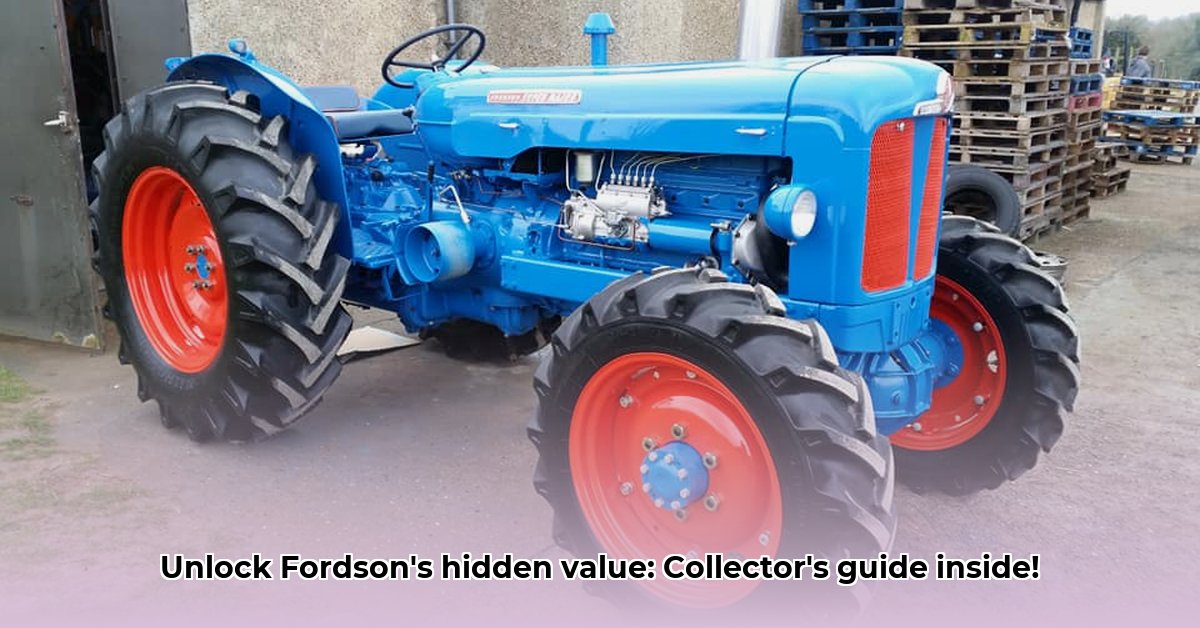
A Historical Overview: Fordson's Legacy in Agriculture
The Fordson tractor, particularly the Power Major, Dexta, and Super Major models, represents a pivotal moment in agricultural history. These machines, introduced at a time when farming relied heavily on manual labor and animal power, revolutionized agricultural practices with their increased efficiency and power. Their robust construction and innovative features quickly cemented their reputation for reliability, making them highly sought-after collectibles today. But what drives the continuing interest and value of these classic tractors? Let’s explore the historical context and current market dynamics. For more in-depth information on Fordson tractors, visit the Fordson Major Tractor website.
The Fordson Power Major, with its substantial power output, significantly improved farming productivity compared to earlier models. Its design innovations, such as improved power transmission and robust construction, contributed to its long-lasting success. The Dexta, a more compact and maneuverable version, perfectly suited smaller farms and tighter workspaces. Finally, the Super Major inherited the best features of its predecessors, enhancing power and refinement. Each model possesses unique characteristics that significantly impact its value in today’s collector’s market, with factors such as originality and rarity playing key roles.
Market Analysis: Trends and Regional Variations in Fordson Tractor Value
The Fordson tractor market demonstrates noteworthy price variability, influenced by a range of factors. A meticulously preserved, original Power Major can command prices exceeding $10,000, while a project tractor requiring substantial restoration might sell for a fraction of that. This disparity underlines the influence of numerous elements on a Fordson's overall value. Auction data reveals compelling trends:
- Condition: A tractor in exceptional condition commands a premium. A fully functional machine with minimal wear and tear is worth significantly more than one in need of restoration. This is consistent across all models.
- Completeness: The presence of original implements, tools, and documentation significantly increases a Fordson's value. Think of it as the difference between a bare-bones car and a fully-optioned luxury model.
- Location: Market prices vary geographically. Established collector markets in regions like the UK and Europe often show higher prices due to increased demand and a denser collector base.
- Rarity: The scarcity of specific models or unique variations directly impacts value. A rare or historically significant Fordson tractor can fetch surprisingly high prices.
Below is a summary of observed pricing ranges, based on auction data and collector insights. These are estimates only, and actual prices can deviate considerably based on the individual tractor's condition and provenance.
| Model | Condition | Approximate Price Range (USD) |
|---|---|---|
| Power Major | Excellent | $5,000 - $10,000+ |
| Power Major | Fair/Restoration | $500 - $3,000 |
| Dexta | Excellent | $3,000 - $6,000 |
| Dexta | Fair/Restoration | $500 - $2,000 |
| Super Major | Excellent | $4,000 - $8,000+ |
| Super Major | Fair/Restoration | $750 - $3,000 |
Isn't it interesting how much condition affects the price? How can we best navigate this variability when purchasing a Fordson tractor?
Buyer's Guide: Ensuring a Sound Investment
Purchasing a classic Fordson requires careful due diligence. Treat it as an investment, not a gamble. A thorough pre-purchase inspection is crucial to avoid costly surprises. This step-by-step guide ensures a smooth acquisition.
- Documentation Review: Obtain all available documentation to verify authenticity and track the tractor's history.
- Visual Inspection: Closely examine the tractor for rust, damage, and missing parts. Look for signs of modifications or poorly executed repairs.
- Mechanical Assessment: Check the engine, transmission, and hydraulic systems. Consider engaging a qualified mechanic for a comprehensive evaluation.
- Operational Test: Test-drive the tractor to assess its performance. Listen for unusual noises or vibrations indicating potential problems.
- Parts Availability: Investigate the availability of parts for the specific model and year. This is critical for future maintenance and restoration needs.
Investment Considerations: Risks and Rewards
Investing in a Fordson tractor offers both potential rewards and inherent risks.
Potential Rewards:
- Appreciation: Classic tractor values can appreciate over time, offering a potentially sound long-term investment.
- Personal Satisfaction: Owning and restoring a Fordson can be a personally rewarding hobby, connecting you to agricultural heritage.
- Historical Significance: You are acquiring a piece of history, representing a pivotal era in agricultural innovation.
Inherent Risks:
- Maintenance Costs: Restoration and upkeep can be expensive, requiring careful budgeting.
- Market Volatility: Classic tractor values fluctuate, reflecting market trends and collector demand.
- Storage Requirements: You’ll need secure storage and appropriate insurance for your valuable asset.
Diversification in any investment strategy is key. Don't over-concentrate your assets in a single item.
Conclusion: Navigating the Fordson Market
The Fordson tractor market offers a unique blend of history, passion, and investment potential. By understanding the factors influencing value, following a thorough buying process, and carefully weighing the risks and rewards, you can navigate this exciting market effectively. Remember, diligent research and expert advice are invaluable when navigating the world of classic tractor collecting.